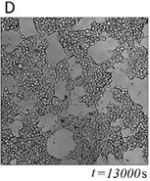EPJ E - Make or break for cellular tissues
- Details
- Published on 10 August 2012

Models developed to study liquids are used to investigate the mechanics of cellular tissues, which could further our understanding of embryonic development and cancer.
In a study just published in EPJE, French physicists from the Curie Institute in Paris have demonstrated that the behaviour of a thin layer of cells in contact with an unfavourable substrate is akin to that of thin fluid or elastic films. Understanding the mechanism by which a thin layer of cells splits into disjointed patches, thus breaking the layer’s structural integrity, bears great significance because the human tissue, or epithelium, covering organs can only fulfil its role if there are no holes or gaps between the cells.
Thanks to the analogy between the cellular layer examined and the well-understood behaviour of thin liquid films, the scientists Stéphane Douezan and Françoise Brochard-Nyart devised a model of the layer’s evolution. They considered it as an active, amorphous material made of a continuum of cells. Because it is subject to a constant competition between neighbouring cell-cell and cell-substrate adhesion, it can either maintain its contiguous structure or break.
The authors investigated the layer’s stability when subjected to chemical and physical disturbances. In particular, they scrutinised how the cellular layer reacted to a non-adhesive substrate with little chemical affinity with the cells. They also subjected the cells to a physical disturbance by laying them in substrates with low stiffness, such as soft gels.
The researchers observed what is known as the dewetting phenomenon, whereby the cellular layer is ruptured leading to islands of cells interspersed with dry patches. Dewetting is normally observed in viscous polymer films on slippery surfaces. They concluded that the dewetting phenomenon is due to the cells' distinctive sensitivity to the nature of its substrate, particularly to its decreased stiffness. This means that active, living cells remain governed by the law of physics.
Dewetting of cellular monolayers.
S. Douezan and F. Brochard-Wyart, Eur. Phys. J. E (2012) 35: 34, DOI 10.1140/epje/i2012-12034-9




